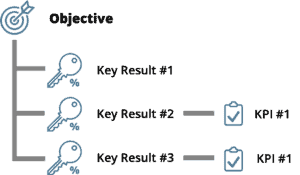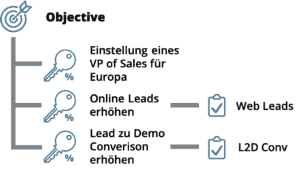
04 Jun OKR vs. KPI: What’s the difference?
OKR vs KPI: What’s the difference?
In our conversations with many OKR enthusiasts and interested parties, the question of the difference between OKR and KPI is one of the most frequently asked questions. Typical follow-up questions are:
- What are the differences between OKR and KPI?
- What do OKR and KPI have in common?
- Do we even need OKR if we have KPI?
KPIs and their limits
KPI.org defines KPIs as follows: “Key Performance Indicators (KPI) are the critical (key) indicators of progress towards an intended result.” The term KPI has been very popular over the last two to three decades. At the most basic level, KPIs measure one aspect of your business. Let’s take a closer look at the individual terms in their definitions and decipher their meaning.
- Key: provides a tool to achieve or understand something
- Performance: defines a specific action, deed or procedure
- Indicator: Indicates the status or level of something
Turnover, turnover per employee, turnover per sales employee, etc. – You can measure all of this. These measurements or indicators show you how your company is currently doing. There are thousands of such measurements, all of which can give an indication of how your company is doing. From these thousands, you select the few – the KPIs for your company and for the corresponding business functions are therefore your most important performance indicators.
Put simply, a KPI is used to thoroughly review the productivity, effectiveness and efficiency of employees, staff and individual teams.
However, when it comes to managing your business, it’s not enough to just identify great KPIs. Every company already has a plan and a budget for each year. These plans and corresponding budgets are usually based on forecasts of KPIs, based on what you have done in the past and what you want or expect to achieve this year. This is where OKR comes into play.
The role of the OKRs
Imagine you are going somewhere by car, for example to Paris. If Paris is your destination, your OKR is the vehicle and your KPI is the dashboard. Your OKR is the vehicle that takes your car to its final destination in Paris, while your KPI tells you how your car is doing on the way to your destination. OKR and KPI can therefore be used to achieve the same goal – but they fulfill different functions.
There are things that are important to you on the way to your goal, but which are not included in any dashboard. For example, one of the most important criteria is that you arrive at your destination safe and sound. So if you fall asleep at the wheel, you will most likely not reach your destination. So making sure you don’t fall asleep and drive carefully is one of the crucial elements of getting to your destination – which isn’t necessarily measured by a KPI.
OKR offers a simple and powerful approach to setting business goals, measuring progress and achieving greater success. As an extension of the trip analogy, you can use the OKR dashboard to check the KPIs such as fuel level, engine oil level, vehicle speed, etc. along your route.
The relationship between OKR and KPI
An OKR set consists of a target and key results. The key results can in turn be linked to a KPI – the emphasis is on can. Key results therefore do not necessarily have to be assigned to a KPI.
Let’s look at another example:
So you want to increase sales and achieve three key results in the current quarter, which you have set in motion. Of these three key results, the first – “Hiring a VP of Sales for Europe” – cannot really be tracked using a KPI or assigned to a KPI.
However, the other two are each assigned to a KPI and are likely to be associated with specific baseline and target values. For example, the key result could be: “Increase web leads (KPI) from 22 to 35 per day”.
Summary
As you have seen, OKRs comprise the KPIs. They help you to achieve the goals that your company has set itself – and at the same time you can achieve your goal well. These goals or key results can optionally be defined, measured and tracked with the help of KPIs.
We, the OKR experts, will be happy to advise you!







